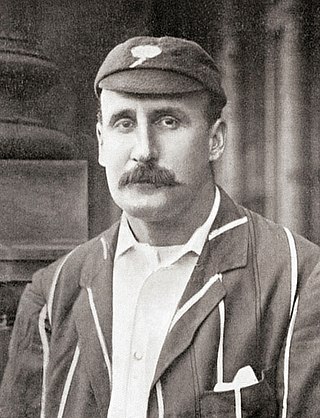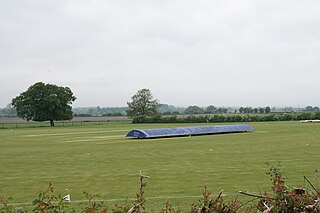
Colonel H. H. Shri Sir Ranjitsinhji Vibhaji II, Jam Saheb of Nawanagar,, often known as Ranji or K. S. Ranjitsinhji, was the ruler of the Indian princely state of Nawanagar from 1907 to 1933, as Maharaja Jam Saheb, and a noted Test cricketer who played for the English cricket team. He also played first-class cricket for Cambridge University, and county cricket for Sussex. He is widely known as the "Father of Indian Cricket", as he was one of the earliest top-class Indian cricketers to play the sport.

The Oxford University Parks, commonly referred to locally as the University Parks, or just The Parks, is a large parkland area slightly northeast of the city centre in Oxford, England. The park is bounded to the east by the River Cherwell, though a small plot of land called Mesopotamia sits between the upper and lower levels of the river. To the north of the parks is Norham Gardens and Lady Margaret Hall, to the west the Parks Road, and the Science Area on South Parks Road to the south. The park is open to the public during the day, and has gardens, large sports fields, and exotic plants. It includes a cricket ground used by Oxford University Cricket Club.

Martin Bladen Hawke, 7th Baron Hawke, generally known as Lord Hawke, was an English amateur cricketer active from 1881 to 1911 who played for Yorkshire and England. He was born in Willingham by Stow, near Gainsborough, Lincolnshire, and died in Edinburgh. He appeared in 633 first-class matches, including five Test matches, as a righthanded batsman, scoring 16,749 runs with a highest score of 166 and held 209 catches. He scored 13 centuries and 69 half-centuries.

Archibald Campbell MacLaren was an English cricketer who captained the England cricket team at various times between 1898 and 1909. A right-handed batsman, he played 35 Test matches for England, as captain in 22 of those games, and led the team to defeat in four Ashes series against Australia. An amateur, MacLaren played first-class cricket for Lancashire, captaining that county for most of his career. As a batsman, MacLaren was one of the leading cricketers of his time and had a reputation as a fast-scoring stylist. In 1895, he scored 424 runs in an innings against Somerset which was the highest individual score in first-class cricket until 1923 and remained a record in English cricket until 1994. Opinions were divided over his captaincy. He was a deep thinker on the game and critics believed him to be tactically advanced, but his pessimism, clashes with the selectors and inability to get the best out of his players led most commentators to rate him a poor leader.

Schofield Haigh was a Yorkshire and England cricketer. He played for eighteen seasons for Yorkshire County Cricket Club, for England from the 1898/99 tour to 1912, and was a Wisden Cricketer of the Year in 1901.

Lionel Charles Hamilton Palairet was an English amateur cricketer who played for Somerset and Oxford University. A graceful right-handed batsman, he was selected to play Test cricket for England twice in 1902. Contemporaries judged Palairet to have one of the most attractive batting styles of the period. His obituary in The Times described him as "the most beautiful batsman of all time". An unwillingness to tour during the English winter limited Palairet's Test appearances; contemporaries believed he deserved more Test caps.
1900 was the 11th season of County Championship cricket in England. Yorkshire finished the season unbeaten to take the championship title and were the first unbeaten champions since the official competition began in 1890. Defending champions Surrey finished seventh. Lancashire were second, and the matches between the two top teams both ended in draws; Yorkshire made 230 in the first innings of the first game, compared to Lancashire's 96, but still could not force a victory, and in the second, with a crowd of over 44,000 present over three days at Old Trafford, Yorkshire took a lead of seven runs on first innings, but as only two and a half hours of play had been possible on the second day, the game was drawn. Sussex, who finished third with 18 of 24 matches drawn, enjoyed 2,000 runs from Ranjitsinhji for the second season running, as he bettered the record for most runs in a Championship season to 2,563. There were no international matches during this season.

The Australian cricket team toured England during the 1902 English cricket season. The five-Test series between the two countries has been fondly remembered; in 1967 the cricket writer A. A. Thomson described the series as "a rubber more exciting than any in history except the Australia v West Indies series in 1960–61". Australia had won the previous three Test rubbers between the two countries, and now won their fourth successive series, by two matches to one with two draws. In the process they "beat the records of all their predecessors in the country" by losing only two of 39 matches during the tour, their defeats being against England in the Fifth Test and in the first of their two fixtures against Yorkshire. The remaining 37 matches gave 23 wins for Australia and 14 draws.
William Henry Micklethwait was an English amateur first-class cricketer, who played one match for Yorkshire County Cricket Club in 1911.

St George's Road Cricket Ground in Harrogate hosted 98 first class matches between 1882 and 2000.
The 1896 County Championship was the seventh officially organised running of the County Championship, and ran from 4 May to 31 August 1896. Yorkshire County Cricket Club claimed victory that year, winning 16 of their 26 matches and losing only three. Five of Yorkshire's players made over 1,000 runs in the season, including John Brown who was placed third nationally, while Yorkshireman Bobby Peel was sixth highest wicket taker and Schofield Haigh held one of the leading bowling averages. Although Yorkshire had a crop of players accruing these statistics, Kumar Shri Ranjitsinhji of Sussex took the plaudits for the most runs that year, 1,698, at the highest average, 58.55, while Surrey's Tom Richardson took the most wickets – 191, and William Attewell of Nottinghamshire returned the best average – 14.63 for his 87 wickets.
Septimus Brutton was an English first-class cricketer and solicitor.
George Bull was an English cricketer. He was a fast bowler.
The Magdalen Ground was a cricket ground in Oxford, England. The ground was owned by the University of Oxford and used by Magdalen College, a constituent college of the University of Oxford. Originally forming the northern point of Cowley Marsh, the ground was initially associated with the Magdalen College School, whose students played cricket there. By 1829, the Oxford University Cricket Club had been given a part of the marsh where the College School played cricket. In 1851, it was purchased at auction by the University of Oxford and leased to the University Cricket Club. The ground operated as a first-class cricket venue from 1829 to 1880, hosting 69 first-class matches. The University Cricket Club left the ground following the 1880 season to play at the University Parks from 1881.

Butt's Way is a cricket ground between the villages of Aston Rowant and Kingston Blount in Oxfordshire.

Christ Church Ground is a cricket ground in Oxford, England. The ground is owned by Christ Church, a constituent college of the University of Oxford. Owing to the University Parks being on public land where an admission charge could not be levied, the privately owned Christ Church Ground was the preferred venue in Oxford for matches where a gated admission was to be levied on spectators, typically in matches between Oxford University and a touring international team. The ground operated as a first-class cricket venue from 1878 to 1961, hosting 37 first-class matches. After 1961, the University Parks became the preferred venue for all first-class matches in Oxford, but it remained in use in minor counties cricket by Oxfordshire until the start of the 21st century. Today the ground is used by the Christ Church Cricket Club.

Bullingdon Green was a cricket ground south of Oxford, England. It was associated with the Bullingdon Club and was an important site in the early history of cricket in Oxford. The ground operated as a first-class cricket venue in 1843, hosting two first-class matches. It was subsequently built on in 1876 with the Cowley Barracks.
Sir Francis Weatherby was an English cricketer, later a soldier and horse racing official.
Jack Francis Mendl was an Argentine first-class cricketer and educator.












